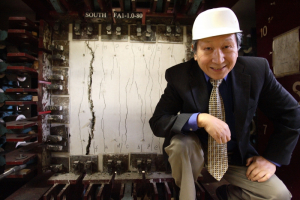Worldwide, dozens of nuclear power plants are scheduled for construction during the next decade, while hundreds more will be reviewed and examined by regulators. Thanks to the efforts of a University of Houston Cullen College of Engineering professor, the designers and operators of these facilities will have the most up-to-date guidelines on nuclear plant infrastructure available in one book.
“Infrastructure Systems for Nuclear Energy,” published by John Wiley & sons this month, is edited by Thomas Hsu, John and Rebecca Moores Professor with the Department of Civil and Environmental Engineering, along with Chiun-Lin Wu and Jui-Liang Lin, both with the National Center for Research on Earthquake Engineering in Taiwan.
The book includes 31 peer-reviewed chapters that cover the design and analysis of everything in a nuclear power plant save the reactor and its piping. These chapters fall into four main sections:
- An overview of nuclear plant infrastructure,
- Containment structures,
- Computer software for containment structures, and
- Nuclear waste storage facilities.
The book grew out of a conference organized and chaired by Hsu in 2010. The International Workshop on Infrastructure Systems for Nuclear Energy was held in Taipei, Taiwan in December of that year. The conference was truly international in nature, with invited speakers from China, France, Italy, Japan, Korea, the Netherlands, Switzerland, Taiwan, and the United States.
From the outset Hsu and his collaborators planned to use the conference presentations as the basis for a book on nuclear infrastructure. Initially, he said, they expected to have the book published by the Spring of 2012, a little more than a year after the conference.
But on March 11, 2011, less than three months after the gathering, a magnitude 9.0 earthquake struck off the coast of Japan, causing a five-meter tsunami. These combined to cause massive damage and large radiation leaks at the Fukushima Nuclear Power Plant.
“Fukushima had a huge impact on this book,” said Hsu. “The disaster revealed a lot about how to design a nuclear power plant. Almost every chapter in this book had to be changed. In some cases, there were just a few small adjustments. In others, the changes were quite extensive.”
To complete the book, in fact, Hsu spent fifteen months as a visiting professor in Taiwan, where, in addition to teaching classes and recruiting graduate students to the University of Houston, he spent many long hours working with his co-editors on the book. The end product, he said, should serve as a central resource for students learning how to design and analyze these plants; as a comprehensive reference for the plant designers; as a resource that will help existing operators to improve their facilities; and as a guiding document for academics to recognize the direction of future research.
“Obviously, everyone wants nuclear power plants to be designed and built in the absolutely safest way possible,” said Hsu. “With this book, we believe we have created the definitive guide on how to build and to operate these facilities.”
